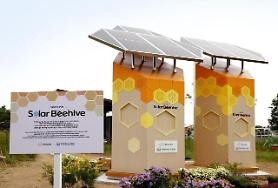
[Courtesy of Jincheon County]
A solar panel is made of materials such as glass, aluminum, silicon and copper. It generates direct current electricity using sunlight as a source of energy. The total generation capacity of solar power generator installations in South Korea increased from 79-megawatt-hours in 2011 to 4,126-megawatt-hours in 2020. The generation capacity of 4,126-megawatt-hours can power some 4,126,000 households annually.
More discarded solar modules will be generated as the number of solar power generation facilities increase. According to the Korea Environment Institute's data, 9,665 tons of discarded solar modules would be discarded in 2023. Recycling a ton of discarded modules can reduce 1.2 tons of greenhouse gas emissions.
The completion ceremony of the recycling center was held on December 21 in Jincheon County some 89 kilometers (55 miles) south of Seoul. Due to the popularization of solar power plants, Jincheon expected that discarded solar modules will cause various social and environmental problems. The official operation of the facility will begin in January 2022 after a test run. The center has various types of facilities that can collect, separate and recycle discarded modules.
"I hope the recycling center will be the model that many other related companies can benchmark. We will try our best to provide the necessary support," Choi Jin-hyuk, the industry ministry official was quoted as saying.
Copyright ⓒ Aju Press All rights reserved.


![[K-Tech] Hanwha Q Cells joins US petition to curb solar panel imports from Chinese-controlled firms](https://image.ajunews.com/content/image/2025/07/18/20250718110410353245_278_163.png)

